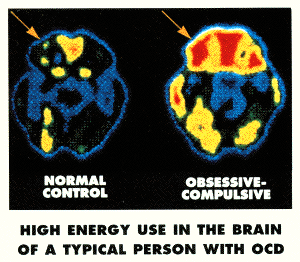According to the 2005 National Comorbidity Survey-Replication study, about 2.2 million American adults have obsessive-compulsive disorder (OCD), a brain disorder that often begins in childhood. The persistent, unwanted thoughts and rituals of OCD sometimes take over people’s lives to the point that they can’t work or maintain relationships or engage in everyday tasks and social interactions.
YESTERDAY
- The standard treatment for OCD was a type of long-term psychotherapy aimed at overcoming psychological defenses. There was no evidence that this treatment was effective.
- Clinicians lacked objective measurements that could help them accurately diagnose OCD – a crucial prerequisite for appropriate treatment.
- There were no proven medications for OCD.
- OCD was thought of primarily as a psychoanalytic issue, not a brain disorder.
TODAY
- Effective treatments are now available. Among them are antidepressant medications that act on serotonin, one of several neurotransmitters (brain chemicals) through which brain cells communicate with each other. These medications also act on brain systems and circuits involved in OCD. Recently developed antipsychotic medications may become another option when prescribed alongside standard medications for hard-to-treat patients with OCD.
- A type of psychotherapy called “exposure and response prevention,” which breaks the cycle of repetitive behavior, is an effective treatment for many patients.
- Clinicians now have objective tools for identifying OCD subtypes and measuring their severity, allowing treatment to be personalized.
- Imaging studies show that people with OCD have differences in specific brain areas, compared with other people. Successfully treated patients have brain-activity patterns like those of healthy people.
- Traditionally, OCD was thought to “run in families.” Genetic studies now suggest that variations in certain genes are involved and that risk is higher when certain variations occur together.
- Researchers are following up on early evidence that infection from the Streptococcus bacterium might lead to some cases of OCD.
- Using genetic engineering, NIH-funded researchers created an OCD-like set of behaviors in mice. They then reversed these behaviors with antidepressants and genetic targeting of a key brain circuit. The study suggests new strategies for treating the disorder.
TOMORROW
- Researchers are studying the potential of deep-brain stimulation, a surgical technique that stimulates cells in specific brain areas, for patients who don’t respond to other treatments.
- Genetics research may help clinicians decide what treatments are likely to work for each patient. Whether a treatment works may be partly due to variations in certain genes.
- Imaging, molecular biology, and genetics research are pointing the way to brain mechanisms involved in OCD. Features of these mechanisms are potential biomarkers that could identify people at risk – a key to early intervention.
- Research to identify brain mechanisms involved in OCD also holds the potential to reveal targets for better medications with fewer side effects.
(Source: http://report.nih.gov/NIHfactsheets/ViewFactSheet.aspx?csid=54&key=O#O)
According to the helpguide.org; Obsessions are involuntary, seemingly uncontrollable thoughts,
images, or impulses that occur over and over again in your mind. You don’t want
to have these ideas but you can’t stop them. Unfortunately, these obsessive
thoughts are often disturbing and distracting.
Compulsions are behaviors or rituals that you feel driven to act out
again and again. Usually, compulsions are performed in an attempt to make
obsessions go away. For example, if you’re afraid of contamination, you might
develop elaborate cleaning rituals. However, the relief never lasts. In fact,
the obsessive thoughts usually come back stronger. And the compulsive behaviors
often end up causing anxiety themselves as they become more demanding and
time-consuming.
Most people with obsessive-compulsive disorder (OCD) fall into one of the
following categories:
- Washers are afraid of contamination. They usually have
cleaning or hand-washing compulsions.
- Checkers repeatedly check things (oven turned off, door
locked, etc.) that they associate with harm or danger.
- Doubters and sinners are afraid that if everything isn’t
perfect or done just right something terrible will happen or they will be
punished.
- Counters and arrangers are obsessed with order and
symmetry. They may have superstitions about certain numbers, colors, or
arrangements.
- Hoarders fear that something bad will happen if they throw
anything away. They compulsively hoard things that they don’t need or use.
Implications for Home and School
-Unable to shift thoughts
-Difficulty focusing/concentrating on work
-Intense feelings of fear/anxiety
-Difficulty with social adjustment
-Repeated negative thoughts/actions that impact relationships
What to do
The most effective treatment for obsessive-compulsive disorder is often
cognitive-behavioral therapy. Antidepressants are sometimes used in conjunction
with therapy, although medication alone is rarely effective in relieving the
symptoms of OCD.
If you are concerned that you may be experiencing symptoms of OCD, talk with your family physician. Your family doctor can refer you to the most suitable treatment in your area.
Online Resources
|

No comments:
Post a Comment